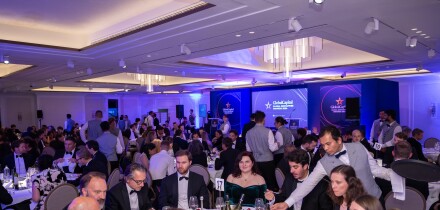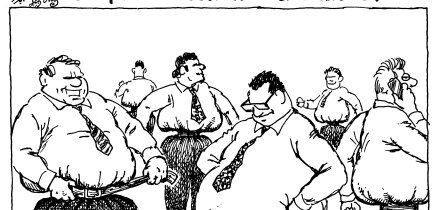Liquid European option prices are readily available in all markets for a wide range of strike prices and maturities. These options are usually priced using the standard Black-Scholes model, which assumes that the volatility of the underlying process is a constant (trivially extended to assume that volatility is a deterministic function of time only).
This implies that the asset follows a lognormal process with this volatility regardless of the asset level at future times. If the market were to price options according to that model, then implied volatilities for traded options would vary with maturity, but would be the same for all strikes at a given maturity. It is well known that this behaviour is not observed.
In general the market has a smile or smirk volatility structure with respect to strike. This is telling us that the implied market distribution is no longer lognormal, and has higher order moments (eg. skew and kurtosis). Kurtosis produces fatter tails at both ends of the distribution, whereas skew tends to increase one end and decrease the other. These market features can be seen in the figure below.
For example, in the equity markets the implied volatility is higher for lower strikes, with the smile becoming less pronounced at longer maturities. The fat tail is therefore more pronounced for lower spots and is a reflection of the markets aversion to market crashes.
The need for a volatility smile model is not, of course, to value European options but rather to hedge them or value other option types in the context of the market information provided by European option prices. For example, while a European option of arbitrary strike and maturity could clearly be valued using a volatility interpolated from observed implied volatilities, it is far from clear which volatility is appropriate to use in the Black-Scholes model for pricing a barrier option, whether one choses the volatility at the strike, barrier, or at some other value.
PUSHING BLACK-SCHOLES
One approach for capturing some of the smile when pricing barrier options is to 'trick' Black-Scholes. First, consider an outside barrier option. This is a vanilla option on one underlying, with the barrier event dependent on a second, correlated underlying. This can be valued in a generalised Black-Scholes framework and the analytical formula depends on the volatilities ** 1 and ** 2, as well as their correlation. A barrier option can then be priced by setting the correlation to one, ** 1 to the volatility at the strike level and ** 2 to the volatility at the barrier level.
Another example is the pricing of digital options. A digital call at strike K can be hedged using a call spread, which consists of a long call with strike KL < K and a short call with strike KU > K. The notional of the two calls has to be adjusted by the factor 1/( KU - KL ). The digital call price is then given by the limit of this call spread as (KL ,KU ) *K, and can be substantially different from the Black-Scholes digital price. The correction term is proportional to the strike slope of the volatility surface.
ALTERNATIVE DISTRIBUTIONS AND PROCESSES
The presence of a smile invalidates the lognormal assumption of Black-Scholes, and this can be incorporated by considering alternative distributions.
There are many approaches to generating a distribution with skewness and kurtosis. One such approach is simply to consider a linear combination of lognormal distributions. Another useful approach is to approximate the real distribution at a given maturity by an (Edgeworth) expansion around the lognormal Black-Scholes distribution. For example a four-moment model can be achieved by performing this expansion and matching the mean and variance. The third and fourth moments can be found by fitting the distribution to the skew and kurtosis found in the market.
Instead of making alternative assumption about the distribution of the underlying at maturity, one can consider alternative processes to the geometric Brownian motion used in Black-Scholes. A widely-used alternative is the jump-diffusion process, which has more potential to capture the fat-tail effects present in the market.
DETERMINISTIC VOLATILITY MODELS.
The most natural extension to the Black-Scholes model is to extend the asset process so that the asset volatility is a deterministic function of the underlying level, namely,
The instantaneous volatility *(St, t) is known as local volatility. The quantities ** (K,T) and *(St,t) are quite distinct. The former is a property of a particular traded option, the latter a property of an asset price process and is not a market observable.
In making * a function of the asset level, one loses the analytical tractability of Black-Scholes but produces a single implied asset process that produces correct prices for all input strikes and maturities. This then leads naturally to a consistent pricing scheme for other structured and exotic options in the presence of our smile surface.
Calibration of this model requires determining the local volatility function *(St, t) such that the European call price CT,K for a particular strike, K and maturity, T agrees with the call price available in the market. This can be achieved by optimising a parametric form for the local volatility surface. However here an implied diffusion theory is used to extract the local volatilities:
in terms of call spreads (CT,K+K - CT,K), butterfly spreads (CT,K+K + CT,K-K - 2CT,K) and calendar spreads (CT+T,K - CT,K). This model assumes a continuum of market option prices across both strike and maturity, which is unrealistic. However, by a careful choice of interpolation and extrapolation techniques for the implied volatility surface this can be achieved. Alternatively one could use another smile model (eg four moments) to price the options required for the local volatility calculation above.
Intuitively, the price of a path-dependent option will be an expectation over all possible paths St each of which picks up the local volatility *(St, t), for t * [0,T]. Consequently the price of say a barrier option will be determined, not by a single volatility, but by the whole implied volatility surface, thus rendering obsolete the question of which volatility to use for pricing.
The effect of volatility smiles on hedging strategies can now be investigated. It turns out that the implied deltas and gammas can deviate quite considerably from the Black-Scholes results. For example, in the equity market Black-Scholes can result in significant 'over-hedging'. This can be seen by looking at the following approximation for Delta,
Due to the volatility skew present in the implied volatility surface, and magnified in the local volatility surface, C(S+ *S) is smaller than in the Black-Scholes model (because the asset samples a region of lower volatility than in Black-Scholes). Similarly C(S- *S) is larger, and hence the price difference and hedging ratios are smaller (by as much as 20%). This effect obviously becomes more pronounced with higher skews. A second article will deal with stochastic vol models and provides a discussion and comparison of the approaches.
This week's Learning Curve was written by Marcus Overhaus, global head of quantitative research in the equity derivatives group at Deutsche Bankin London.





